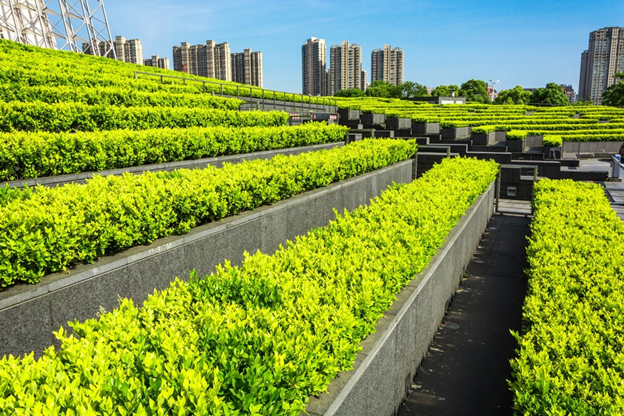From Sky to Plate: The Rise of Vertical Farming and Its Potential to Feed Cities
F r o m S k y t o P l a t e : T h e R i s e o f V e r t i c a l F a r m i n g a n d I t s P o t e n t i a l t o F e e d C i t i e s

Imagine strolling through a bustling cityscape, past towering skyscrapers that aren’t just symbols of commerce, but vibrant havens of greenery. Imagine rows of lettuce cascading down illuminated walls, ripe strawberries nestled within multi-story structures, and juicy tomatoes basking under artificial sunshine – all within the heart of the city. This isn’t a futuristic fantasy, but the burgeoning reality of vertical farming, a revolutionary approach to agriculture poised to transform how we feed our ever-growing urban populations.
Driven by the dual pressures of population growth and shrinking arable land, vertical farming is rapidly gaining traction worldwide. These high-tech greenhouses, stacked vertically in urban centres, are revolutionizing agriculture by utilizing controlled environments to optimize crop production. Gone are the vast swathes of farmland sprawling across rural landscapes; instead, imagine skyscrapers transformed into verdant farms, utilizing sophisticated technologies like hydroponics and aquaponics to cultivate crops vertically, maximizing output in minimal footprints.
Beyond Hype: The Compelling Advantages of Vertical Farming
So, what makes vertical farming so exciting? What sets it apart from traditional agriculture and why should we consider it a viable solution for feeding our cities? Here are some key advantages that paint a compelling picture:
- Space Odyssey: Defying Limitations: While traditional agriculture requires vast swathes of land, often encroaching on natural ecosystems, vertical farms thrive in controlled environments. They utilize vertical space to its fullest, maximizing production in even the smallest of footprints. This makes them ideal for urban areas with limited land availability, offering a beacon of hope for cities struggling to balance human settlements with food production. Imagine thriving farms nestled amidst bustling cityscapes, contributing to urban aesthetics and sustainability simultaneously.
- Year-Round Bounty: Seasons Be Damned: Forget the limitations of seasons! Vertical farms offer the ultimate indulgence – year-round harvests unaffected by weather fluctuations or pesky pests. This ensures consistent supply and a wider variety of fresh produce, even in harsh climates. Craving juicy strawberries in the dead of winter? No problem! Vertical farms cater to your appetite, regardless of the calendar or Mother Nature’s whims.
- Sustainability Champion: Embracing Responsibility: While traditional agriculture often carries a heavy environmental footprint, vertical farming champions sustainability. These controlled environments allow for precise control over water usage, often employing recirculating systems to minimize waste. They rely less on harmful chemicals for pest management and nutrient control, opting for precise monitoring and targeted solutions. Moreover, their proximity to urban centres reduces transportation needs, further minimizing their carbon footprint. In a world grappling with climate change and resource depletion, vertical farming offers a refreshing shift towards environmental responsibility.
- Quality & Safety Paramount: From Farm to Plate with Confidence: Traditional agricultural practices, with their reliance on open fields and unpredictable weather, can sometimes compromise food safety. Vertical farms, however, offer a haven of control. Tightly controlled environments allow for meticulous monitoring of factors like temperature, humidity, and nutrient levels, resulting in consistent quality and reduced risk of contamination. From seed to plate, vertical farming offers greater transparency and assurance, allowing consumers to enjoy their food with peace of mind.
Challenges and Opportunities: A Glimmering Future
It’s important to remember that while vertical farming’s potential is undeniable, it isn’t without its challenges. High initial investment costs, energy consumption, and the need for specialized technologies are potential hurdles. However, as the technology matures and economies of scale are achieved, these costs are expected to decrease, making vertical farming more accessible and widely adopted.
Innovation is already addressing these challenges. Optimizing energy efficiency through renewable energy integration, utilizing intelligent automation to streamline processes, and continuous research and development are helping to make vertical farming a more viable and sustainable solution. Additionally, government support and public awareness campaigns can play a crucial role in accelerating its adoption and fostering a wider understanding of its benefits.
From Skyscrapers to Dinner Plates: A Paradigm Shift
Vertical farming represents more than just a novel way to grow food; it signifies a paradigm shift in our relationship with food. It fosters local food systems, empowers urban communities by creating local job opportunities, and promotes environmental sustainability. It’s a glimpse into a future where cities aren’t just consumers of food, but active participants in its production, cultivating their own sustenance within their concrete jungles.
While vertical farming isn’t a silver bullet, it’s a powerful tool in our arsenal for addressing the complex challenges of food security in a world with a growing population and limited resources. By embracing and supporting this innovative approach, we can pave the way for a more sustainable future where cities not only consume but also cultivate their food, one skyscraper farm at a time.
Join the Conversation!
What are your thoughts on vertical farming? Do you see it playing a significant role in the future of our food system? Share your comments and questions below! Together, let’s explore the possibilities and discuss how we can leverage

Katerina Monroe
@katerinam • More Posts by Katerina
Congratulations on the award, it's well deserved! You guys definitely know what you're doing. Looking forward to my next visit to the winery!










